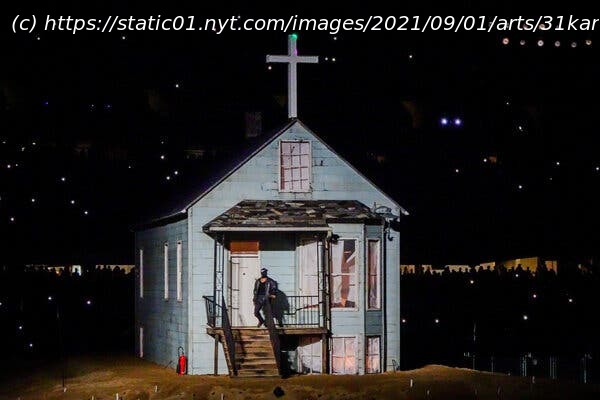West is still one of the most influential pop stars of the century, but multidisciplinary spectacle is more his goal than music now, and he isn’t the star of his own 10th album.
For the last few years, Kanye West — perhaps tired of the insufficiency of the album, or music-making in general — has been seeking increasingly grand canvases for his various projects. There was the 2016 Yeezy Season 3 fashion show and album debut held at Madison Square Garden. His Imax film, “Jesus Is King,” filmed in James Turrell’s land art installation Roden Crater, in Arizona. A domed prototype for affordable housing built on his property in Calabasas, Calif. A vast expanse of ranch outside Cody, Wyo., annexed for work and play. And now, for the rollout of his 10th album, “Donda,” stadiums — two listening sessions cum performance pieces in Atlanta starting in July, and a third last week in Chicago. New music may have been the raison d’être for these events, but it is not his sole goal, not anymore, not really. Instead, these last few weeks have been album rollout as multimedia soap opera. The music itself has been in flux — the version of “Donda” played at each event has been different — and West’s refining of it in public, a method he introduced with “The Life of Pablo,” is his true artistic project now. It is an ideal strategy for West, still among the most influential pop stars of the 21st century, an artist who is almost incalculably popular and yet almost wholly removed from the pop music mainstream. Gathering tens of thousands of people on short notice and engaging in a public conversation about what his music might sound like may be the purest expression of his fame now. But crucially, big stages are easy places to hide. They are terrific distractions. And as West has cycled through periods of public tumult in recent years — his hospitalization, his assertion that slavery was a choice, his embrace of Donald Trump, his fitful 2020 run for president — he has simultaneously been orchestrating ever more complex creative projects while slowly removing himself from their emotional center. That is a challenging place from which to launch “Donda” — named for West’s mother, who died in 2007 following a cosmetic surgery procedure — an urgent but sometimes center-less album that finds common ground between the scabrousness of “Yeezus” and the ethereality of his recent gospel turn. Given that it is an album dedicated to his mother’s memory, “Donda” is only intermittently emotional — more an achievement of texture and logistics than catharsis. West remains capable of orchestrating impressive pop music. “Hurricane,” with sweet vocals from the Weeknd, is disarmingly pretty. “Junya” pulses with church organ and SoundCloud rap puckishness. “Believe What I Say,” which samples Lauryn Hill — one of the few times you hear a woman’s voice on this album — is among the most easeful songs West has made in a decade. Several songs, including “No Child Left Behind,” “Jesus Lord” and “24,” sound like kin to the music West was making during his embrace of gospel. (He excised all cursing from this album, even bleeping out his guests.) But there are songs, like the recycled Pop Smoke collaboration “Tell the Vision” and the drowsy “Moon,” that feel purely decorative. As a Kanye West album, it feels more like a stabilization than an innovation. Once a wordplay-obsessed, self-aware lyricist, West has shifted in the last decade to a more terse and immediate approach, one that complements his musical shifts toward the industrial and the spiritual.






